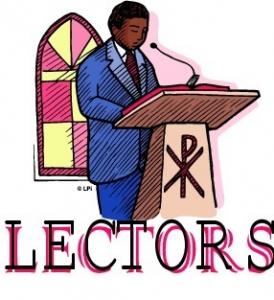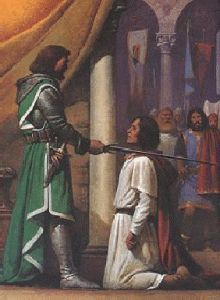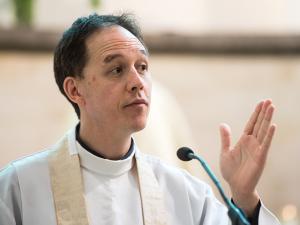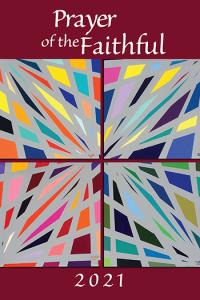
Eye contact between lectors and members of the assembly is a relationship. As a trainer of lectors (I’ve written a book), as a lector myself, and as a person in the pew, I see two parts of that relationship. There’s a way to make the lector’s part easier, but it’s only even possible when the assembly does its part.
I feel sorry for lectors in my church. They try so hard to follow the rule that says they’re supposed to make eye contact with people in the assembly. But (a) Books tell them to do it but not how, and (b) They can’t do it anyway because most of their audience is not making eye contact with them. I don’t know how it is in your church, but sitting in my pew, I see the lector’s head bobbing up and down, trying to make eye contact with people whose eyes are studiously focused on a page in their missalettes.
So here are two lessons, one to encourage the people in the assembly to do their job during the Liturgy of the Word, the other for lectors, who, I believe, will find at least their part of eye contact relationship easier.
Eye Contact for the Assembly.
The Liturgy of the Word is a celebration of the presence of God. It is not study time or a time for worrying whether you understood everything. At the Liturgy of the Word God’s people share a word that God has written on their hearts.
“Sharing” is an important idea. It’s an active, community thing. You won’t find God’s presence in black and white in your book while others around you find God’s presence in their books. The Liturgy of the Word doesn’t bring God to individuals one at a time. The book—except for those with impaired hearing—is a hindrance to experiencing God’s presence in the communal activity. (It’s a wonderful thing when some parishes include hearing-impaired people into the common experience by providing a simultaneous sign language interpretation of the readings.)
All of this means that the person in the assembly has an important job to do in the Liturgy of the Word, namely: Look at the lector. Look at the one who is sharing the word of God with you. Allow that person to make eye contact with you, the way we do when sharing stories among friends and family. These are our stories and, just like what often happens around the table or a campfire, they are stories we’ve heard before. I don’t always remember hearing a particular reading before, but I know that this sharing has been going on my entire life and will continue, making me who I am and am becoming. At the moment my participation in the sharing is more important than making sure I don’t miss a word.
The sharing that occurs at Mass can be enhanced by checking out the Sunday readings before you go to church. That’s the time for not missing a word. Even then you won’t get everything out of what you read. That’s why we have a repeating cycle of Mass readings.
Eye Contact for Lectors
Most lectors that I’ve seen put a lot of effort into both the reading and following the rule that says: Make eye contact with the assembly. This is not the easiest thing to do, but many lectors make it harder than it has to be. What I observe often is that lectors look up many times during a reading, more than once per sentence even. Of course, they have to look down again quickly so they don’t lose their place. The person in the assembly does not get the feeling of actually being looked at. This way makes eye contact both difficult and ineffective.
There’s a better, easier way that both feels more comfortable to the lector and looks more natural to the listener. First, cut down the number of times you make eye contact. Once per sentence is often more than enough. Second, the natural place to look up is at the end of a sentence. You will see the period coming a few words in advance, and when you know what those last few words are, then look up. Keep your gaze on the assembly for all of those words—four or five is often not too many to keep track of. Then look back at your place. The time that this requires is just about right for a pause at the end of a sentence.
There’s nothing set in stone here. You don’t have to look up for every sentence, and some really long ones, like those Paul likes to write, might be right for two looks. I often find a part of a reading where the thought seems to be addressed more personally to the listeners. I definitely want to make eye contact then.
Last point: The most effective way to make eye contact is to actually connect with a particular person in the assembly. That’s why you especially want your listeners looking at you instead of at their books. Pick out a different person in a different part of the assembly each time you look up. Look them in the eye. Of course, that takes time, but if you follow the first instruction, you’ve given yourself time.
You may enjoy this method of making eye contact. You may feel more connected with your listeners. At least, you will avoid the danger of a stiff neck from too much bobbing your head up and down.












